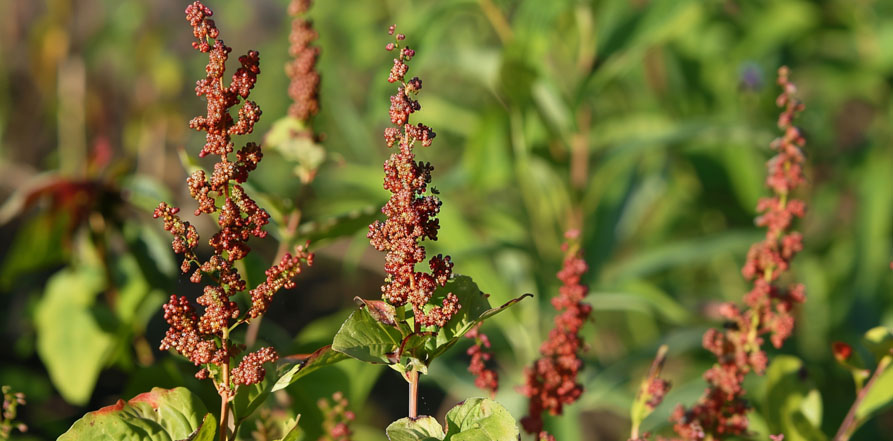By Donnie Yance
Yellow Dock (Rumex crispus) has established itself as an invaluable botanical medicine with a rich history of traditional use across multiple healing systems. Since the 1700s, yellow dock has been one of the most revered medicinal plants in western traditional medicine. Yellow dock possesses a unique therapeutic profile as both an immune modulator and a nourishing tonic for the blood, liver, and bone marrow.1,2
Yellow dock root stands as one of the premier blood tonics in the Western herbal tradition. Indigenous peoples of North America also used yellow dock for various medicinal purposes, including treating digestive complaints, skin conditions, infections, and cancer. One Eclectic Physician, named Dr. Vassar of Ohio believed that Yellow Dock is the best remedy known to prevent the inroads made by cancer on the human system. Its exceptional ability to support healthy iron levels and hemoglobin formation makes it the herbal practitioner’s first choice for addressing conditions characterized by iron deficiency. Unlike pharmaceutical iron supplements, yellow dock provides naturally bioavailable iron complexed with other compounds that enhance absorption while minimizing gastrointestinal side effects.3,4
The herb’s blood-building capacity is complemented by its cholagogue action (helping the flow of bile), which improves fat digestion and enhances nutrient assimilation. As noted by the Eclectic physician Finley Ellingwood, yellow dock “has a direct influence upon the blood, and thence upon diseases of the skin and mucous membranes. It acts directly in its restorative influence, purifying the blood, removing morbific material, and quickly cures the disease conditions. It is valuable in ulcerative stomatitis, in sore mouth, and in ulceration of the stomach with great lack of tone, it has no equal in these conditions.” 5
Rumex possesses a wealth of chemical constituents and pharmacological activities with great promise, approximately 224 constituents have been isolated and identified from Rumex, including anthraquinones, naphthalene derivatives, flavonoids, essential oils, coumarins, stilbenes, and others. The crude extracts and isolates of R. crispus exhibit antitumor, antimicrobial, antioxidant, anti-inflammatory, anti-osteoporotic, antidiabetic, anti-allergic, and other actions.6

Yellow Dock’s Health Promoting Actions And Mechanisms
- Alterative action: By gently supporting detoxification pathways, yellow dock helps remove metabolic waste products that can burden immune function.7
- Protective – Redox/Antioxidant activity: Research demonstrates yellow dock’s ability to decrease lipid peroxidation while increasing glutathione and other antioxidant enzymes, protecting immune cells from oxidative damage.8,9,10
- Liver Health: Possesses hepatoprotective properties, meaning it may help protect the liver from damage and promote its detoxification function.11
- Anemia Support: Yellow dock is regularly used as an herbal treatment for both iron deficiency anemia and bone marrow related anemia (chemotherapy/radiation).
Yellow dock is a traditional remedy for pregnant women who may experience both anemia and constipation.12 - Immunomodulation: Studies indicate yellow dock enhances immunoglobulin production, with research on related species showing significant increases in IgG and IgM levels.13
- Soothes Inflammation: Traditional use and modern research suggest yellow dock helps modulate inflammatory responses, a critical aspect of balanced immune function.14
- Bone Health: A research study found a water extract of yellow dock root helps bone health in two important ways: it promotes the growth of bone-building cells (osteoblasts) while simultaneously slowing down the activity of bone-destroying cells (osteoclasts). When tested in mice with induced bone loss, the extract effectively prevented deterioration of bone structure. These findings suggest that yellow dock root extract could be a promising natural treatment option for osteoporosis, working through specific cellular pathways that both enhance bone formation and reduce bone breakdown.15
- Gum Disease: A 2021 study16 conducted by researchers at the University of Adelaide investigated the efficacy of yellow dock as a treatment for gingivitis. The clinical trial involved 35 participants with documented histories of periodontal disease. Subjects were randomly assigned to either an experimental group that received a yellow dock oral rinse (administered three times daily for 14 days) or a control group that received a placebo solution. Results demonstrated that participants in the yellow dock treatment group exhibited significantly reduced adhesion of Porphyromonas gingivalis bacteria—a primary pathogen associated with periodontal disease—on both dental and gingival surfaces. These improvements were observed at both the 7-day and 14-day assessment intervals when compared to the placebo group, suggesting yellow dock’s potential as an effective natural intervention for gum disease.
- Cancer Support: Numerous research studies have shown Rumex crispus as a promising source of anticancer compounds.17 Researchers tested extracts from the Rumex crispus root to see if they could suppress colorectal cancer cells. They found that one particular extract, called L19, was very effective at killing these cancer cells. This extract works by triggering the cancer cells’ self-destruction mechanisms and activating inflammatory responses.18
- With Chemotherapy: Researchers found that combining yellow dock extract with a common chemotherapy drug, 5-FU (5-fluorouracil), helps kill lung cancer cells more effectively than either treatment alone. The combination works by blocking a specific cellular pathway (PI3K/Akt) that cancer cells need to survive, triggering their self-destruction through a process called apoptosis. This discovery suggests a potential way to improve cancer treatments with fewer side effects by using natural compounds alongside conventional drugs.19
Formulation Considerations
For blood-building formulations, a typical proportion would include yellow dock as 15-30% of the formula. For immune support blends, 10-20% is generally sufficient to provide therapeutic benefits while allowing space for complementary immune herbs.
Yellow dock represents a perfect example of how traditional herbal wisdom continues to be validated by modern research. Its dual role as both blood tonic and immune supporter makes it an essential component in formulations addressing anemia, immune deficiency, inflammatory conditions, bone loss, and detoxification needs. When properly formulated with synergistic herbs, yellow dock offers a safe, effective approach to addressing fundamental aspects of health and vitality.
Conclusion
Yellow dock is a powerful herb with a long history of supporting general health as well as specific conditions. It is especially useful for supporting the blood, liver, bones, and immune system. Both traditional healers and modern scientists recognize its many benefits, such as improving iron levels, helping with detox, reducing inflammation, and even fighting cancer cells. Studies also show it can protect the liver, strengthen bones, and support people going through chemotherapy. Yellow dock works best when used with other herbs in carefully balanced formulas. Its ability to support key organ networks makes it an important tool for natural healing and overall wellness.
About the Author:
Donald R. Yance is the founder of the Mederi Center. A Clinical Master Herbalist and Certified Nutritionist, Donnie is renowned for his extraordinary knowledge and deep understanding of the healing properties of plants and nutrition, as well as of epigenetics, laboratory medicine, oncologic pathology, and molecular oncology. He is a professional member of the American Herbalists Guild, National Association of Nutrition Professionals, Academy of Integrative Health and Medicine, and the Society for Integrative Oncology.
References:
1. Li, J.-J.; Li, Y.-X.; Li, N.; Zhu, H.-T.; Wang, D.; Zhang, Y.-J. The genus Rumex (Polygonaceae): An ethnobotanical, phytochemical and pharmacological review. Nat. Prod. Bioprospect. 2022, 12, 21
2. Babulka, P. Les rumex, de l’ethnobotanique à la phytothérapie moderne (Rumex spp.). Phytothérapie 2004, 2, 153–156.
3. Kuhn, M. & Winston, D. (2008). Winston & Kuhn’s herbal therapy and supplements [2nd ed.]. Philadelphia, PA: Wolters Kluwer Health.
4. Ellingwood, Finely, M.D. The American Materia Medica, Therapeutics and Pharmacognosy, 1919, https://www.henriettes-herb.com/eclectic/ellingwood/index.html
5. ELLINGWOOD, FINLEY M.D. (1919), Ellingwood’s American Materia Medica, Therapeutics and Pharmacognosy – Page 47
6. Qian H, Jia Y, Zheng K, Li C, Shao J, Wang J, Xu H, Zhou X. Rumex crispus L.: A comprehensive review on botany, traditional uses, phytochemistry, pharmacology, and safety. Int Immunopharmacol. 2024 Dec 25;143(Pt 3):113569. doi: 10.1016/j.intimp.2024.113569. Epub 2024 Nov 12. PMID: 39520965.
7. Kuhn, M. & Winston, D. (2008). Winston & Kuhn’s herbal therapy and supplements [2nd ed.]. Philadelphia, PA: Wolters Kluwer Health.
8. Maksimović Z, Kovacević N, Lakusić B, Cebović T. Antioxidant activity of yellow dock (Rumex crispus L., Polygonaceae) fruit extract, Phytother Res. 2011 Jan;25(1):101-5. doi: 10.1002/ptr.3234.
9. Bouafia A, Laib I, Laouini SE, Azzi M, Alharthi F, Souwaileh AA, Abdullah JAA. Comprehensive Bioactivities and Phytochemical Profiling of Rumex vesicarius: Antioxidant Potential, Anti-Diabetic Properties, and Anti-Biofilm Effects Under Thermal Treatment. Chem Biodivers. 2025 Apr 7:e202500329. doi: 10.1002/cbdv.202500329. Epub ahead of print. PMID: 40193246.
10. Maksimović Z, Kovacević N, Lakusić B, Cebović T. Antioxidant activity of yellow dock (Rumex crispus L., Polygonaceae) fruit extract. Phytother Res. 2011 Jan;25(1):101-5. doi: 10.1002/ptr.3234.
11. Prakash Mishra A, Sharifi-Rad M, Shariati MA, Mabkhot YN, Al-Showiman SS, Rauf A, Salehi B, Župunski M, Sharifi-Rad M, Gusain P, Sharifi-Rad J, Suleria HAR, Iriti M. Bioactive compounds and health benefits of edible Rumex species-A review. Cell Mol Biol (Noisy-le-grand). 2018 Jun 25;64(8):27-34.
12. Hoffmann, D. (2003). Medical Herbalism: The Science and Practice of Herbal Medicine. Rochester, VT: Healing Arts Press.
13. Banday MT, Wani MA, Othman SI, Rudayni HA, Allam AA, Alshahrani MY, Ibrahim EH, Nabi S, Adil S. Impact of Rumex nepalensis on Performance, Blood Markers, Immunity, Intestinal Microbiology and Histomorphology in Broiler Chicken. Vet Sci. 2024 Oct 1;11(10):463. doi: 10.3390/vetsci11100463. PMID: 39453054
14. Bouafia A, Laib I, Laouini SE, Azzi M, Alharthi F, Souwaileh AA, Abdullah JAA. Comprehensive Bioactivities and Phytochemical Profiling of Rumex vesicarius: Antioxidant Potential, Anti-Diabetic Properties, and Anti-Biofilm Effects Under Thermal Treatment. Chem Biodivers. 2025 Apr 7:e202500329. doi: 10.1002/cbdv.202500329. Epub ahead of print. PMID: 40193246.
15. Shim KS, Lee B, Ma JY, Water extract of Rumex crispus prevents bone loss by inhibiting osteoclastogenesis and inducing osteoblast mineralization, BMC Complement Altern Med. 2017 Oct 26;17(1):483. doi: 10.1186/s1290601719867.
16. Selbach S, Klocke A, Peters U, Beckert S, Watt RM, Tong R, Flemmig TF, Hensel A, Beikler T. Microbiological and Clinical Effects of a Proanthocyanidin-enriched Extract from Rumex acetosa in Periodontally Healthy Carriers of Porphyromonas gingivalis: a Randomized Controlled Pilot Study. Planta Med. 2023 Sep;89(11):1052-1062. doi: 10.1055/a-1728-2249.
17. Bhandari, M., & Clark, B. (2015). Extraction of anti-cancer water-soluble compounds from Rumex crispus. The FASEB Journal, 29.
18. Mohammadhosseinpour S, Bhandari M, Lee DA, Clack B. Anti-Proliferative and Apoptotic Activities of Rumex crispus. Life (Basel). 2023 Dec 20;14(1):8. doi: 10.3390/life14010008. PMID: 38276257; PMCID: PMC10819952.
19. Ginovyan M, Javrushyan H, Hovhannisyan S, Nadiryan E, Sevoyan G, Harutyunyan T, Gevorgyan S, Karabekian Z, Maloyan A, Avtandilyan N. 5-fluorouracil and Rumex obtusifolius extract combination trigger A549 cancer cell apoptosis: uncovering PI3K/Akt inhibition by in vitro and in silico approaches. Sci Rep. 2024 Jun 25;14(1):14676. doi: 10.1038/s41598-024-65816-5. PMID: 38918540; PMCID: PMC11199614.

